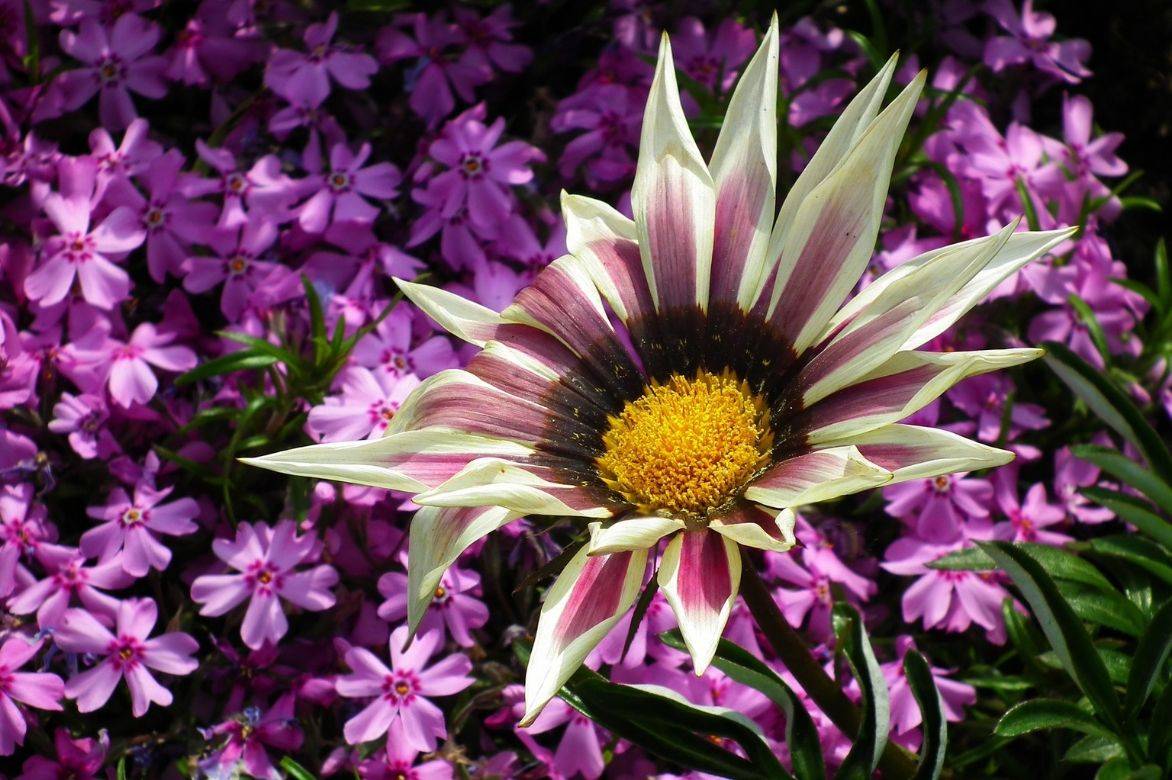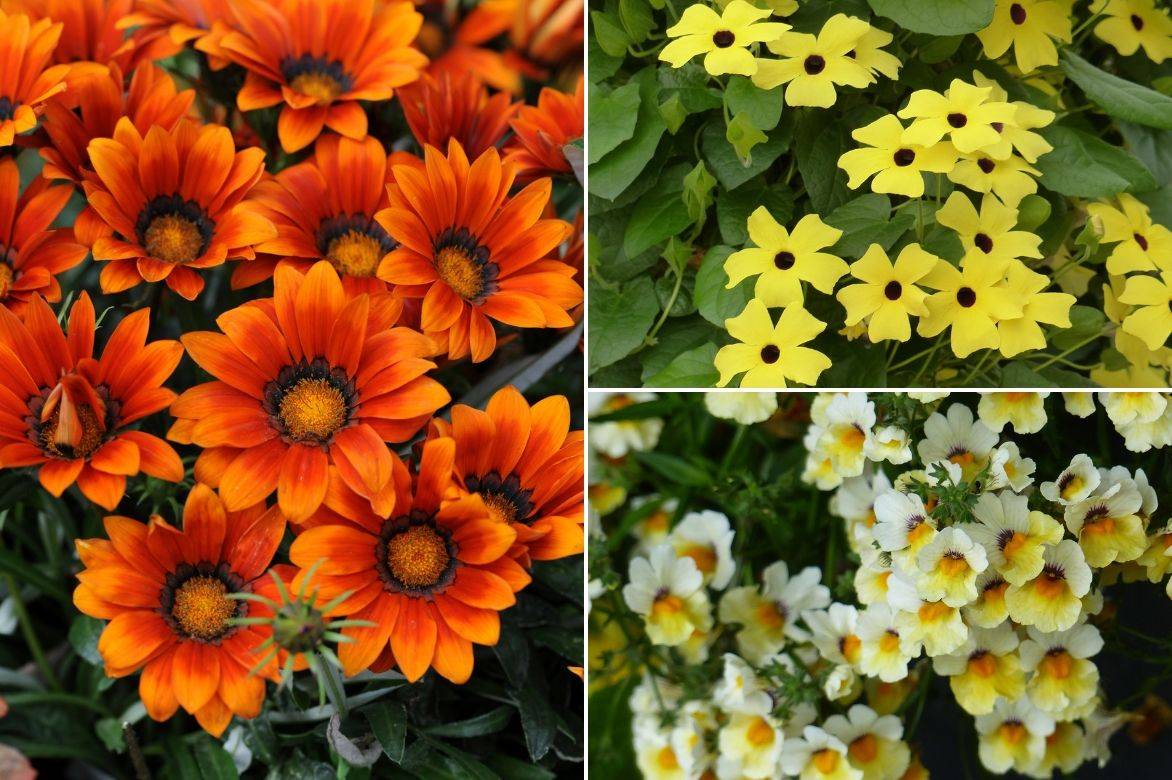
Gazania: sowing, planting and care
Contents
Gazania, in a nutshell
- Gazanias are low-growing plants with a long summer flowering period
- Perennials but tender, they are most often grown as annuals.
- They form a rosette of silvery-green leaves topped by flowers like large suns in warm, contrasting shades.
- Very easy to establish from sowing or as bedding plants, gazanias do well in poor, dry soils and in good light but do not tolerate stagnant moisture.
A word from our expert
Gazanias or Gazanies are sun-loving plants with bright colours, usually grown as an annual in our climates. Tireless. This small South African herbaceous is very easy to grow in dry, poor soil. It flowers from spring until the first frosts without interruption. New flowers open each day as soon as the sun is at its zenith and close in the evening. The cultivars offered are usually hybrids, such as the Daybreak series, which manage to flower under medium light levels, unlike the wild species.
Gazanias are perennial in warm, relatively dry-winter climates such as the Mediterranean or the South-West, tolerant down to -10°C. They self-seed very easily, often producing a mix of shimmering colours: orange, carmine red, brown, yellow through to cream, bicolours with sometimes a dark maculate spot at the base of the “petals” (ligules). They can also be kept under cover as cuttings taken in May or October, especially if you wish to favour particular colours.
Sow seeds under glass from February to April. For more information, also consult our dossier Sowing annual seeds: how to succeed, in open ground or in trays
Their compact tufts in a rosette of narrow simple or lobed grey-green leaves provide a setting for these large flowers, which brighten borders or enliven summer beds, surrounded by plants with a light habit such as Gauras, Buenos Aires verbena (Verbena bonariensis), baby’s breath or Agapanthus, another South African plant whose sky-blue or white tones calm the intensity of the Gazanias’ warm hues.
Description and botany
Botanical data
- Latin name Gazania
- Family Asteraceae
- Common name Gazania, Gazanie
- Flowering from May to October
- Height between 0.10 and 0.30 m
- Sun exposure sun
- Soil type poor, dry and free-draining soil, even calcareous
- Hardiness fairly low (-10 °C)
Gazania constitute an austral and tropical genus comprising 18 species. It is a species from South Africa and Mozambique, Gazania rigens (syn. Gazania splendens), that is the origin of most forms cultivated for borders. These cultivated forms bear larger flowers and are less demanding in heat than wild forms typical of the coastal dunes of the Cape. Gazania belong to the family Asteraceae, like daisy or Coreopsis.
Typical species, Gazania rigens, about 30 cm across, bears head inflorescences in yellow or bright orange around an orange centre speckled with black and brown. It is a herbaceous perennial and evergreen plant, generally grown as an annual in cool, humid climate. In southern France it can remain perennial thanks to mild winters but above all because of summer drought.
Plant forms within a few weeks a dense mass of small rosettes of leaves not exceeding 20–30 cm across. Basal leaves, sessile, about ten centimetres long, are narrow obovate, up to 3 cm wide, sometimes deeply lobed (pinnatifid). Lamina of rather dark green bears a thick shiny cuticle (wax) that protects it from dehydration, as well as a white felt covering on the underside. Form Gazania rigens var. leucolaena, with sun-yellow heads, shows both faces of the lamina white and woolly; leucolaena means ‘white cloak’.
Heads are borne on stems little or not ramified, very leafy, up to 40 cm long, from which white latex exudes when wounded. But in cultivated forms, heads generally appear singly as in wild variety, Gazania regens var. uniflora. Each “sun” is carried on a sturdy, short peduncle 10–15 cm high arising from the rosette of leaves and facing the sky. Sterile ligulate flowers, arranged alternately on two concentric circles, form the ray florets of the head, displaying very colourful shades, sometimes bicoloured or marked with a dark brown spot at the base. Centre of the head, with a velvety aspect, consists of dark tubular flowers that bear sexual organs, pistils and stamens. Head size often exceeds 7 cm and even reaches 12 cm in diameter in hybrids such as New Day Tiger Stripe Mix. Heads of Gazania, like those of Suns (sunflowers), attract a myriad of pollinating insects, beneficial to vegetable garden.
Fruits are achenes that detach from the receptacle throughout the season. It is best to remove faded flowers every 2–3 days to stimulate formation of new buds.

Several colours of Gazania
Main varieties of Gazania

Gazania Big Kiss White Flame F1 Seeds - Treasure flower
- Flowering time June to November
- Height at maturity 30 cm

Gazania rigens Kiss Gold F1 - Treasure flower
- Flowering time June to November
- Height at maturity 20 cm

Gazania New Day Mix F1 Seeds - Treasure flower
- Flowering time June to November
- Height at maturity 30 cm

Gazania Tiger Stripes Mixed Seeds - Treasure Flower
- Flowering time June to November
- Height at maturity 30 cm

Gazania rigens Big Kiss White Flame
- Flowering time June to November
- Height at maturity 30 cm
Discover other Gazania seeds
View all →Available in 1 sizes
Available in 1 sizes

Available in 1 sizes
Available in 1 sizes
Available in 1 sizes
Available in 1 sizes
Available in 1 sizes
Available in 1 sizes
Available in 1 sizes
Sow Gazania
Sowing gazania is easy. Do it from February to April in a warm place, at home or under heated cover.
Voici comment procéder :
- Soak the seeds for a few hours in a glass of water.
- Sow the seeds in sowing substrate moistened the day before, covering them with 3 mm of fine substrate.
- Press down with a board, then water gently.
- Keep them warm between 18 and 25 °C in a mini-greenhouse or a heated greenhouse, maintaining the substrate slightly moist.
- Seedlings emerge after 2 to 4 weeks.
- Prick out the seedlings into buckets when they can be handled.
- Wait until frosts have ended, in April–May, before planting out in the ground.
Planting
Where to plant Gazania?
Gazania plants provide continuous flowering from May–June until October. They thrive by the sea on sandy, light, poor soils exposed to drought, full sun, wind and sea spray. They also adapt very well to sheltered conditions in a town garden—within a border, a rockery, on a terrace or on a balcony—provided soil is well drained, not too rich and aspect is relatively sunny. Cultivars are less demanding in terms of sun and do not close at the slightest cloud. Gazania plants prefer neutral to calcareous soils but tolerate acidic soils.
When to plant?
Plant young plants in buckets in April–May once frosts are no longer a threat, or proceed with sowing under cover from February.
How to plant?
- To create a continuous tapetum, space Gazania young plants 20–30 cm apart.
- Dip rootballs in a bucket of water to thoroughly moisten them.
- Work the soil, remove weeds, add gravel or sand if it tends to be compact.
- Dig staggered holes corresponding to the width of the rootballs.
- Fill the holes, firm with your hand then water the bed generously.
In pots or planters, use a well-draining horticultural compost and add one third river sand.

Care
- Gazanias tolerate drought well, though moderate but regular watering improves clump growth and flowering.
- Each day, remove, if possible, faded brown flowers whose corolla has closed in the evening, as the corolla lasts only one day. Do not confuse with buds, which are round and green.
- In cool climates, plants can be grown in pots and overwintered indoors to keep them for several years.
- Below -10°C, plants die, but you may still observe natural sowings in spring.
Multiplication
Easiest way to multiply Gazania is to propagate by cuttings in May or October or sow seed between February and April (See above: sowing Gazanias).
Propagation by cuttings
- Prepare a pot by filling it with 50% potting compost mixed with 50% sand.
- Take 10 cm long tips from herbaceous shoots.
- Remove leaves near base of cutting.
- Insert them to two-thirds of their length after dipping base of stem in plant hormone powder.
- Firm compost gently all around to remove air pockets and ensure good contact between compost and cutting.
- Place them under cover in shade, for example by placing a cut-off clear plastic bottle over them.
- In autumn, separate rooted cuttings and plant them into buckets, then keep them in a bright frost-free room until spring.
- Plant your Gazania in spring in open ground.
Uses and companion plants
Busy gardeners appreciate Gazanias both for their simplicity and the brightness of their large heads, like Gaillardia, long favoured in our grandmothers’ gardens. Their vivid colours argue against overuse, but they can be used to add a cheerful touch at the base of a lavender border or brighten a pot planted with a small conifer for the summer.

A planting idea for a planter: Gazania ‘Kiss Bronze’, Thunbergia alata and Nemesia ‘Sunsatia Plus Little Vanilla’ that will cascade nicely
You can also create a scene with Gazanias installed along the edge of a border, paired with the Verbena. In a contemporary or natural garden, Gazania can in small doses blend with taller, single-colour plants with a light habit such as Gaura, Verbena bonariensis, Stipa tenuifolia or Achillea, all equally drought-tolerant.
Their mat-forming habit makes them charming low-maintenance rockery subjects and ideal for heat-baked banks. Gazanias also perform very well in planters placed on a balcony or in urns that adorn a patio or a conservatory.
Further reading
Discover our range of Gazania.
- Subscribe!
- Contents
. Happy gardening! Planting, Sowing, and Maintaining Gazanias
Gazanias, with their vibrant and colourful blooms, are a splendid addition to any garden. Whether you're a seasoned gardener or just starting out, understanding the proper techniques for planting, sowing, and maintaining these young plants is essential for a flourishing display.
**Planting Gazanias**
To plant gazanias, choose a location that benefits from full sunlight as these young plants thrive in bright conditions. Ensure the soil is well-drained; sandy soils are ideal. Plant the gazanias at a distance of about 20-30 cm apart to give each young plant enough space to grow.
**Sowing Gazanias**
If you prefer to start your gazanias from seeds, begin by sowing indoors about 6-8 weeks before the last expected frost. Use a light, well-draining seed starting mix and place the seeds on the surface, gently pressing them into the soil. Keep the soil moist but not waterlogged, and provide plenty of light once the seeds germinate.
**Maintaining Gazanias**
Gazanias are relatively low-maintenance. Water the young plants regularly, especially during prolonged dry spells, but be careful not to overwater. Deadheading spent flowers will encourage more blooms. In colder climates, mulching around the plants can help protect the roots from freezing temperatures.
By following these simple steps, you can enjoy the dazzling beauty of gazanias throughout the growing season. Happy gardening!](https://www.promessedefleurs.ie/blogwp/wp-content/uploads/2019/06/gazania-tout-savoir.jpg)








































Comments